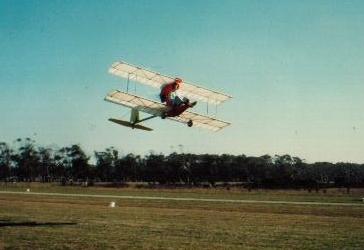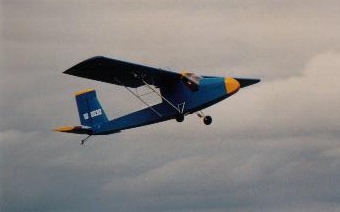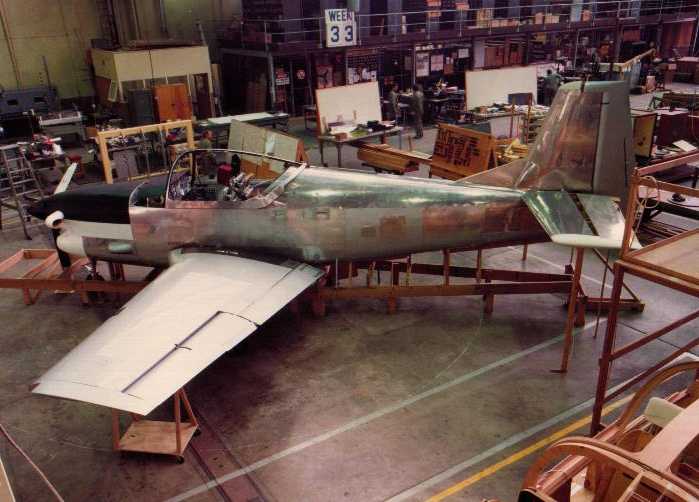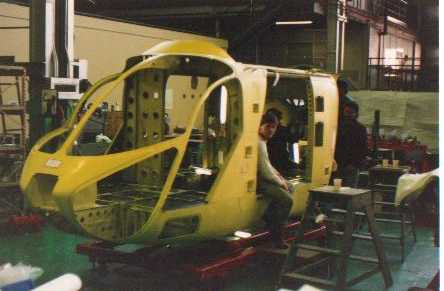Aircraft
I have held a fascination for flight as long as I can remember. As a child my father showed us 16 mm films, in particular a very old title called "Chimp the Aviator". This is an unremarkable short film about a chimp who is eager to fly with his owner in an old biplane. The chimp races down the strip and climbs on to the tail of the aircraft at the last moment. Once in the air the chimp climbs all about the wings of the aircraft much to the chagrin of the pilot, but he is persuaded to sit quietly on the wing where he eats his lunch. This includes sandwiches and a banana, the skin of which he drops from the aircraft and watches as it drops to the ground. Later after landing the chimp is walking back to the club house where upon he trips on the discarded banana peel and then has a word with himself.
It seemed like a one in a million chance, so I was surprised every time he slipped on his own banana peel.
I also found inspiration in an old Jimmy Stewart movie, "No Highway in the Sky". This is an involving drama about an Aerospace Engineer who proves that the new aircraft aluminiums suffer from metal fatigue. As I recall he predicts the exact failure time of an aircraft fin to within seconds! Very impressive!
When I was older I took to building rubber powered models. Most of these were built from kits by AeroFlyte and were of an excellent robust design. Of course this lead to motorized models of the control line variety and eventually to radio control.
For my fifteenth birthday I received a joy flight in a Cessna 150! I thought that was brilliant, and better still the pilot let me fly it for a while!
The Engineer in us all
Well, I thought flying would be marvelous, but as a
five
day a week job I might get sick of it, so better to keep flying as a
hobby.
It seemed that the technical side of aviation could be of great
interest so
I looked to Professional Engineering. What better way of becoming
involved
in aviation than to learn how to design an aeroplane?
So, after a successful Higher School Certificate I
managed
to get into the Royal Melbourne Institute of Technology where I studied
and
earned a Degree in Aeronautical Engineering.
In year 3 of our studies I was drawn to a new Air Navigation Order ano 95.10 which permitted unregistered microlight aircraft to be flown without a pilots license, provided all-up-weight did not exceed 400 lb and you did not fly above 300 ft. Two of my colleagues (Max Kroone and Steven Samagalski) and I decided to build a "Whing Ding II" which is a scant 120 lb empty biplane. We ordered the plans from R.W.Hovey in the US and set to work over Christmas 1977. We received much encouragement from the Institute and in particular from our principal lecturer Dr H.K.Millicer. Looking back, I appreciate this even more today than I did at the time. By Easter 1978 we had the Whing Ding airborne. What a buzz! Firstly the aircraft was powered by a McCulloch 101B racing gokart engine with no exhaust muffler so it was very loud. Way to go! And it was thrilling sitting out front at 40 mph and 50 ft up, simply brilliant. From the practical point of view, the performance was too marginal to actually go anywhere and the chain drive was dreadfully unreliable. (We had to hand crank the 50 inch wooden propeller to start it. I don't think any of us really got comfortable with that).

Whing Ding II
Top speed of the Whing Ding was about 45 mph. The most effective way of climbing out of ground effect was to do so in a series of steps. Once airborne you would scoot along just above the ground until top speed was reached, then you would convert the speed into height. (Usually about 15-20ft, no more). After leveling off, the speed was allowed to increase again to top speed and the process repeated.
Actually , we never got a full circuit out of it. Steven got the closest. We were flying at the private airstrip of Lin Bruty at Gordon (Victoria) near Emu Rock during a minimum aircraft club meet. We had always aimed at being able to do complete circuits and it was Steven's turn, so we encouraged him to give it a real try if things were going well. We thought you would want at least 80 to 100 ft altitude to give yourself clearance above the trees so off he went into the wild blue, climbing quite well at first but then he was not using our funny energy to height climb method and soon trailed up the backside of the power curve. Although he got very high (I guess about 80 ft) he got slower and slower until, with an exaggerated angle of attack he started coming down in a full power mush! Now, there is a dam right at the end of the strip and from where we were it appeared he was going straight into the bloody thing! We just stood, mouths open and watched! In any case he landed heavily on the near side of the dam which did some minor damage to the wing. Whew!
We gave up trying to do circuits at about this time.
My own design, the "Maya"
While still working on the Whing Ding early in '78 I hatched the idea of designing a fully enclosed ultralight with full section wings and tail surfaces. I reasoned that it would be possible to keep to the 400 lb all-up-weight and that I could come up with something in about six months! So I set to work. I started with performance estimates of course, as you do. In the course of design I built two mockups and after many design changes I finished the Prototype over Christmas 1985.

Maya at Tooradin (Victoria)
Design had taken an estimated 8000 hours while construction took around 1500 hours. Material costs $7500 Aust.
I ended with an empty weight of 248 lb and a top speed of 60 mph, with a 4 cylinder Konig SD-570 engine of just 28 hp (at an All-Up-Weight of 424lb). Maximum all-up-weight is 480 lb which is well within the most recent local regulations. It seems to me to be the easiest thing to fly and looks very "aeroplane" like in the air!
After successfully completing the prototype I
thought it
a waist not to publish drawings for the Maya so I spent the following
18
months preparing a complete drawing and manual package which I
distributed
for a few years. (BTW, these drawings are still available).
Hawker De Havilland, Victoria (ne. Commonwealth Aircraft Corporation)
I started working for Commonwealth Aircraft Corporation in May of 1979. I joined the structures design group which lead to some serious involvement in the design of flight control systems on a new aircraft for the Royal Australian Air Force. Although several years and more than $100 million were spent on the design and manufacture of a prototype, the military eventually opted for the Pilatus PC-9. Ah well, I did get to see my own design flying in the shape of the Maya! Ha!

Engineering mockup of Wamira
More recently I have worked as Liaison Engineer on the McDonnell Douglas Explorer, NOTAR helicopter fuselage. This is an interesting machine in that it has no tail rotor as such. An over-sized tail pipe is fed air from an enclosed fan driven directly by the main engine transmission. Rotor anti-torque forces are thus generated by a jet efflux from the end of the tail pipe and by coanda effect around the slotted, curved surface of the tail pipe.
Useful load and performance figures are impressive, while mechanical systems are simplified and noise reduced.

MDX Fuselage at Hawker De Havilland (Victoria)
I am now working for myself and enjoy good variety
of work
in General Aviation including aircraft modification, design and
drafting,
plus some hands-on manufacture and maintenance. One of my more recent
projects involved helping to finish a partially completed Heinz
"Zenith".
contact:- [email protected]